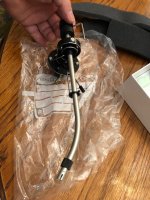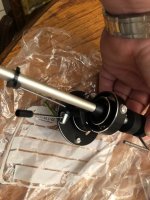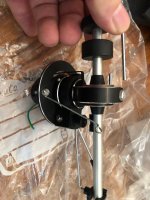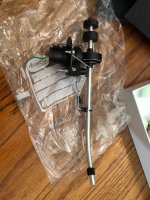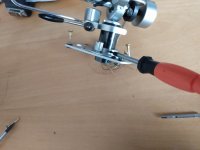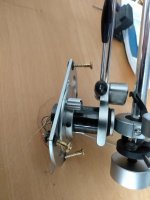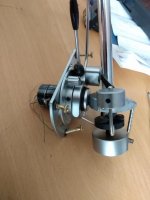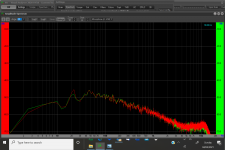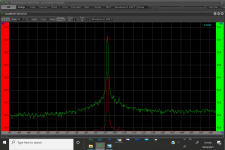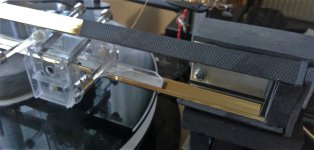Thanks for your words Ralf: particularly appreciated because I know it comes from someone who knows well how much sweat it takes to get off the beaten path.
I've been running around my corKscrew RTA for 6 months before "stumbling" on this box, and I don't even know if it can really work. As you may certainly imagine, the problems don't seem simple.
Now I'm building a TT that has been sleeping for 10 years, but then I'll get my hands on it; some things need to be examined from far.
ciao - carlo
I've been running around my corKscrew RTA for 6 months before "stumbling" on this box, and I don't even know if it can really work. As you may certainly imagine, the problems don't seem simple.
Now I'm building a TT that has been sleeping for 10 years, but then I'll get my hands on it; some things need to be examined from far.
ciao - carlo
Can you guys point me to a post for help in making a diy VTA system? I think that’s what it’s called. I’m building a TT and need to be able to raise and lower the hole arm setup.
Thanks and any help would be great
Thanks and any help would be great
What arm will you use please?Can you guys point me to a post for help in making a diy VTA system? I think that’s what it’s called. I’m building a TT and need to be able to raise and lower the hole arm setup.
Thanks and any help would be great
Interested to know about the TT as well! - maybe OT but we can come back from there!
M
Hello gentlemen
Depending upon your general arm design, consider
re-purposing an old microscope's rack and pinion focusing parts.
Even available new(but expensive...):
Rack and Pinion Focusing Mounts for Imaging Systems
or something like this:
Lens Focusing Mount
Happy Easter to all!
Frank
PS. I have no affiliation with these companies... ;-)
Depending upon your general arm design, consider
re-purposing an old microscope's rack and pinion focusing parts.
Even available new(but expensive...):
Rack and Pinion Focusing Mounts for Imaging Systems
or something like this:
Lens Focusing Mount
Happy Easter to all!
Frank
PS. I have no affiliation with these companies... ;-)
Maybe there are some standard pipe and pipe fittings large enough to take the main mount and you can arrange that the mount progresses on the pitch as you turn them.I bought this from a fourm member. I forgot what it’s off of. Lol
I think it’s off a AR table from the late 70’s early to mid 80’s
I am sure someone has done this!
Are you sure there isn´t a set screw somewhere in the black cylindrical part of the base? It looks very much to me as if you can raise and lower the inner blanck metal cylinder relative to the bas as you can with a lot of other armsI bought this from a fourm member. I forgot what it’s off of. Lol
I think it’s off a AR table from the late 70’s early to mid 80’s
View attachment 938705
View attachment 938706
View attachment 938707
View attachment 938708
View attachment 938709
Has anyone considered that the resonant frequency just is not there at all because of all the motion parts, so a standing wave cannot propagate?
I think its reasonably certain that each small part will have its own resonance, and as they are small and stiff its likely they are quite high frequency, but whether as a system it has one i don't know, and what makes up the system i don't know either.Has anyone considered that the resonant frequency just is not there at all because of all the motion parts, so a standing wave cannot propagate?
I think i demonstrated that there was something around 8-12 Hz that i could move my adding and subtracting weight to the cartridge and top CW pair, but it didn't behave the same on the lower levers.............
I will bore you all again soon with some additional learning from my experimentation with rails in a vertical orientation and see what i can learn from that.
Mike
Good evening Niffy, i changed the rail system to vertical orientation brass rails and hence the cart to suit, no difference to the 23Hz and not the hoped for reduction in resistance either, but its OK so i shall persevere for now.Hi Mike,
I've had a look at the multitude of plots you've posted. I'm thinking that the ~20hz peek might not be the cartridge compliance/effective mass resonance but something else in the system. ..................
The ~20hz peek might be a longitudinal bending mode of the rail. Try adding a large lump of blutak to the left hand end of the rail and see if this moves the 20hz peek to a lower frequency.
Niffy
I feel it leaves only the cartridge carrier or the TT/plinth to study further now.
Plots for interest attached and a pic of this orientation experiment.
Mike
Attachments
It looks very much to me as if you can raise and lower the inner blanck metal cylinder relative to the base as you can with a lot of other arms
Hi koldby,
I could be wrong, but I thought that carlthess40 was making reference to "on the fly VTA" adjustments.
Sincerely
Ralf
Hi koldby,
I could be wrong, but I thought that carlthess40 was making reference to "on the fly VTA" adjustments.
Sincerely
Ralf
Yes Ralf. That’s what I’m looking to do,
Yes Ralf. That’s what I’m looking to do,
Did you find if the two cylinders slide vertically to set height if you remove any grubscrews like Koldby suggested? - if you already have that then its a whole lot easier!!
Hi koldby,
I could be wrong, but I thought that carlthess40 was making reference to "on the fly VTA" adjustments.
Sincerely
Ralf
On the fly VTA? That is quite another story.
Has anyone considered that the resonant frequency just is not there at all because of all the motion parts, so a standing wave cannot propagate?
I think that it is highly likely that the systems inherent damping is great enough to prevent it producing a peek in the frequency response. Even if the resonant peek is suppressed the system will still have a natural resonant frequency. Below resonance the arm will follow the motion of the record surface, albeit with some resistance due to friction. Above resonance the motion of the arm will not follow the motion of the record but remain relatively fixed. The degree to which it remains fixed will reduce with increased frequency. We can tell that the resonant frequency of Mike's arm is in the right ballpark as it tracks warps and eccentricity and plays music.it just finding out exactly where in the ballpark that's the issue.
Niffy
Hi Mike,
I would be surprised if the 23hz was due to the deck. In my books the Origin Live decks are, pound for pound, the best commercial decks available.
Have you tried taking a measurement with the stylus resting on a record with the deck off and with the motor running but the belt removed?
Niffy
I would be surprised if the 23hz was due to the deck. In my books the Origin Live decks are, pound for pound, the best commercial decks available.
Have you tried taking a measurement with the stylus resting on a record with the deck off and with the motor running but the belt removed?
Niffy
I think that it is highly likely that the systems inherent damping is great enough to prevent it producing a peek in the frequency response. Even if the resonant peek is suppressed the system will still have a natural resonant frequency. Below resonance the arm will follow the motion of the record surface, albeit with some resistance due to friction. Above resonance the motion of the arm will not follow the motion of the record but remain relatively fixed. The degree to which it remains fixed will reduce with increased frequency. We can tell that the resonant frequency of Mike's arm is in the right ballpark as it tracks warps and eccentricity and plays music.it just finding out exactly where in the ballpark that's the issue.
Niffy
Thanks
- Home
- Source & Line
- Analogue Source
- DIY linear tonearm
